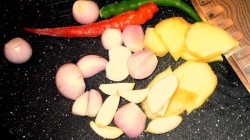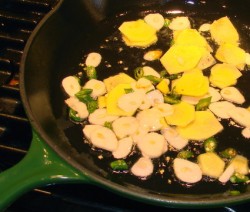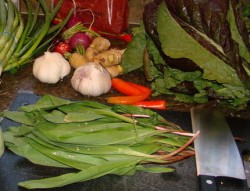Creating Your Own Foolproof Chinese Stir-Fry–Step Two: The Aromatics
If you think of the main ingredients of your stir fry as the stars of your show, then the aromatics are akin to those character actors who bring a delightful amount of color, flavor and realism to a cast. Cast in supporting roles, aromatic ingredients are very much like skilled character actors in that if you, the chef/director, are not careful to reign them in, they can disrupt the show by overpowering your stars and taking over. On the other hand, you don’t want to be so timid that you do not allow the aromatics to shine, and do what they do best, which is bring a stir-fried dish to life with vibrant flavors.
What is an aromatic?
Generally speaking it is a very flavorful dried or fresh spice, herb, or preserved condiment which, when used in small amounts flavors an entire wokful of food. The most familiar fresh aromatics are those from the allium family: onions, garlic, scallions, leeks, shallots.garlic chives and chives. As far as I am concerned, there would be no cuisine without this family of aromatic vegetables/herbs; they are quite simply that indispensable to the kitchens of the entire world.
But there are other quite wonderful and necessary aromatics in the Chinese kitchen. Ginger, which is a rhizome, adds its fresh, tingling flavor to innumerable Chinese dishes. Chile peppers, though a relative newcomer to the shores of China, have become quite popular and are used fresh, dried, fermented, salted, and made into various condiments, such as chile-garlic sauce. Black pepper, star anise, Sichuan peppercorn, cinnamon, and five spice powder are all spices which are used to flavor Chinese foods, including stir fries. Salted dried shrimp, fermented black beans, and fermented vegetables can also play the role of aromatics in a Chinese stir fry.
It isn’t just the strong flavor of an aromatic that determines its role; it is when and how it is used in a stir fried dish that causes me to call it an aromatic, and not either a main ingredient or a condiment. To me, the main factors which determine whether or not an ingredient is an aromatic in a stir fry is that it is used in relatively small amounts,and it is among the first ingredients that are put into the wok, in order to infuse the rest of the ingredients with its flavor.
There is an exception to my rule, of course: some aromatic spices, such as Sichuan peppercorns or black pepper, can be sprinkled over the dish just at the end of cooking to add an extra fillup of flavor. However, in cases such as this, often the aromatic added at the end of the cooking process was also used at the beginning.
Some aromatic ingredients can be used in such quantity in a stir fry that they qualify as main ingredients. A classic example is garlic chives or chive blossoms, which are used as a vegetable in stir fries that contain a small amount of meat. I am personally fond of pork with garlic chives, and chicken with chive blossoms is very good as well.
How does a cook properly use and control these strong-flavored ingredients in order to keep them from taking over the main ingredients of a stir fried dish?
There are several ways. One, is to be aware of what aromatics enhance which main ingredients, and choose them accordingly.
Everything tastes good with tofu. There, I said it. That is part of why I like tofu so much–it is versatile. You can cook it spicy, you can cook it mild. and it is always good. Chicken is like tofu in that all of the aromatics, used judiciously, will enhance its natural savory flavor.
Ginger really enhances beef and freshens its strong flavor; it is also essential with fish and seafood. Garlic is also good with beef, but it really shines with pork and lamb. Scallions are one of the “Heroic Trio” of the Chinese kitchen, and is good with everything, but sometimes I really prefer deeply cooked onions instead. Fermented black beans, in greater or lesser amounts are good with everything, but I really like it with beef and chicken. Chilies are great in anything, as far as I am concerned.
It is also helpful to know that there are classic combinations of aromatic ingredients in Chinese cookery. I have already mentioned the ever-present “Heroic Trio” of scallion, garlic and ginger in a post of all its own, but there are other combinations that are just as tasty. Fermented black beans are good friends with garlic and either chiles or caramelized onions. Ginger, scallion and black pepper are great with seafood. Chile, garlic and fermented black beans are used with clams and I love it with tofu. Leeks, ginger and garlic are amazing with stir-fried lamb. (That is a northern Chinese specialty.)
Secondly, it helps to know how the way the aromatics are cut influences their flavor in a stir fry.
Ingredients which are cut smaller have more surface area. This allows the release of more of the essential oils which add flavor to the stir fry. So, for an intense flavor, minced or pureed aromatics fit the bill. For a strong, but not as overpowering a flavor, thin slices of matchstick stips will work. For subtle flavor, thicker slices are the way to go. The proper technique is to add the aromatics to the stir fry at the beginning of the process, just after
There is a problem, however, with using minced ingredients, especially garlic, in a stir fry. When you heat your wok enough to produce a browned crust on your main ingredients, the heat is intense enough to burn minced garlic on contact, which would cause a very bitter, biting flavor which can utterly ruin a dish.
The way I get around this is that I add the minced garlic on top of the main protein ingredient, whether it is meat of tofu. While the meat or tofu are browning and are left motionless in the wok for that one minute or so, I sprinkle the garlic over the upper surface of the meat or tofu.. The heat and oil simmering up between the pieces of protein cooks the garlic partway, and once the bottom is browned of the meat or tofu, and you start stirring again, the garlic infuses the entire dish with its flavor without burning.
Why choose three aromatics, rather than four or more?
It is easier to learn how the flavors work together in a stir fry if you only use three at a time. Once you become more experienced, then you can start adding one or two other flavors to a stir fry. If you start out with more aromatics, you run the risk of overloading your dishes with flavor and muddying them.
So for now, stick with Barbara’s Rule of Three, and after your stir fries get better, you can discard it like every other outgrown rule you have ever been given.
5 Comments
RSS feed for comments on this post.
Sorry, the comment form is closed at this time.
Powered by WordPress. Graphics by Zak Kramer.
Design update by Daniel Trout.
Entries and comments feeds.






Thanks, Barbara. You continue to post a goldmine on stir-fry techniques.
Comment by TikiPundit — May 4, 2007 #
This series is great, Barbara! For many years I cooked in a little wok that was a gift to me, and it finally was ruined by a well meaning personage trying to “clean” it. After that, I never replaced it, and fell out of the habit of cooking in a Chinese manner. Your last post, about the three aromatics though – so concise and easy to remember – fired me up. I bought a new wok (FINALLY! 5 years it’s been!) last week and have used it twice already. I forgot what a difference the right cookware can make. Just glorious.
Thanks 🙂
Comment by nex0s — May 4, 2007 #
Thank you for this series. I am, right now, having a quick stir-fry at the computer, working on a paper that is due – too – soon. Being incredibly busy lately, I’ve picked up your routine for protein+a green veg+another veg, and not only is it quick, but it’s awesome as well. The green veg were a new addition to my cooking repertoire, and I’m loving it.
Thanks again 😀
Comment by Skavoovie — May 6, 2007 #
I am glad that everyone is enjoying the latest series on stir frying and on simple Chinese cooking.
The Heroic Trio of the Chinese kitchen is a great thing to know about and the formula for protein, green and veg is also simple.
And yes, stir fried greens are hard to beat. And they are so good for you. I feel like an evangelist for greens, but in a good way. They are so delicious and healthy–I am thrilled to know that more people are eating them.
Comment by Barbara — May 6, 2007 #
[…] Aromatics […]
Pingback by Stir Fry-day | the gf-gf — October 12, 2011 #